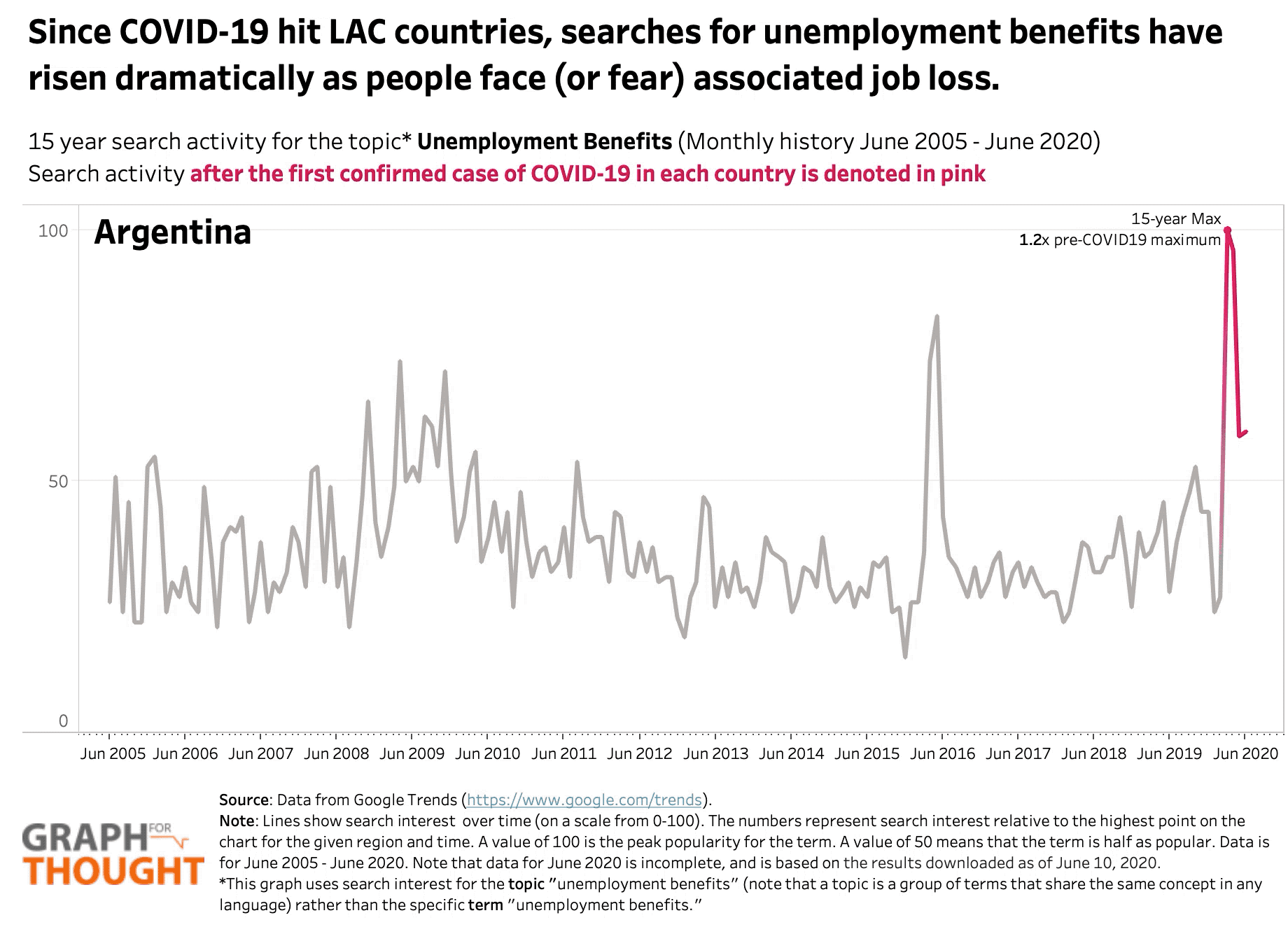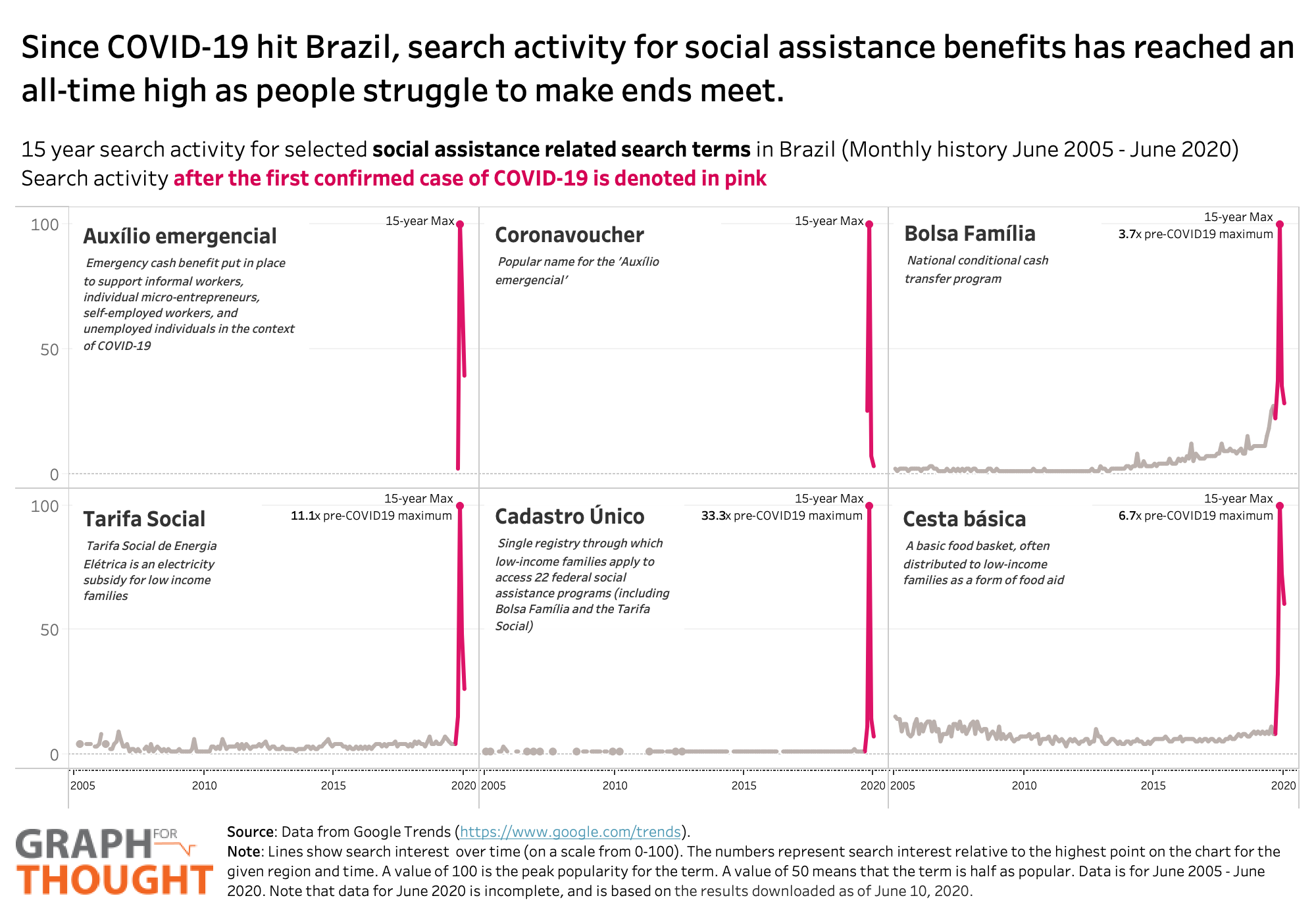Vulnerability at Work: The need to invest in inclusive and resilient social protection systems for all
June 11, 2020

While containment measures such as lockdowns have been critical in combatting the spread of COVID-19, it has also led to an unprecedented wave of associated job losses. In both the formal and informal sector, millions of people are seeing their employment disappear. Data from the United States showing the change in the number of jobless claims shed light on just how generalized the extent of this problem is. Unfortunately, state agencies have been struggling to cope with this massive spike in demand—as systems have become overwhelmed with a backlog of millions of unpaid claims.
In order to support families facing negative income shocks, enhancing state capacity to effectively deliver social protection benefits (such as claims for unemployment insurance from formal workers or claims for social assistance benefits from informal workers) is an essential part of a comprehensive COVID-19 response. We should take into account that most countries in LAC do not have formal unemployment insurance systems. Without systematic administrative data it is difficult to know how the number of claims for social protection benefits is changing in LAC in real time and target the efforts. In the absence of this administrative data, this #GraphForThought uses data from Google Trends to gather an approximate idea of how the volume of people searching for social protection benefits online has changed in the wake of COVID-19. Note that that this post does not attempt to use this data to predict actual indicators (such as the number of claimants or the unemployment rate). Rather, it looks at how post-COVID19 searches for benefits compare to pre-COVID19 levels—to have a better idea of the current scale of the challenge we are collectively facing. Of course, we must keep in mind that changes in search interest could reflect many other factors—such as increased public awareness that certain benefits exist.
The graph shows how search activity for the topic of “unemployment benefits” has changed in seven LAC countries (those with available search query data), using 15 years of monthly data from June 2005 – June 2020. Pre-COVID19 search activity is shown in grey and post-COVID19 search activity is shown in pink. The data is normalized on a scale from 0-100, where the numbers represent search interest relative to the highest point on the chart for the given country and time period (a value of 100 is the peak popularity for the term, whereas a value of 50 means that the term is half as popular). Note that the graph uses the search topic of “unemployment benefits” (a topic refers to “a group of terms that share the same concept in any language”) rather than the search term “unemployment benefits” (which would only show matches for the query terms in the language given). This helps us to compare changes in search activity for the same concept across countries that speak different languages, but also within countries where multiple languages may be spoken.
What we see in the graph is that since COVID-19 hit LAC countries, searches for unemployment benefits have risen dramatically. In all countries except for Chile (where there was a higher spike in 2005), search popularity has reached the highest level in the past 15 years. However, even in Chile, we see a dramatic spike after COVID-19 compared to search interest over the past ten years. This is perhaps unsurprising, as the actual unemployment rate in the city of Santiago, Chile is reported to have reached the highest level in 35 years. The relative jump in search interest is especially large in countries such as Uruguay and Colombia. Respectively, search interest in Uruguay and Colombia following COVID-19 was 5.6 and 11.1 times more popular than at any other point during the 15-year period. In Uruguay, this record interest in searches for unemployment benefits corresponds with a record number of actual unemployment benefit claims. Between April 1-28, Uruguay’s Banco de Previsión Social received over 65,000 benefit claims—over four times the previous maximum (16,000 claims) for any month since May 2003. Recent data from Brazil also suggests that record search query interest corresponds with record job losses—over 1.1 million formal jobs have been lost so far during the pandemic, with the loss in April being the highest for that period since data started being collected in 1992.
While we see a dramatic spike in interest for unemployment benefits, this only tells one part of the story in LAC—a region marked by high levels of informal employment. Workers in this sector would not have access to unemployment insurance—and thus would likely not be searching for these types of benefits in the face of a negative shock to their household income. To get a better idea of how workers in the informal sector may be faring, we can look at how search interest in social assistance programs may be changing. As the names of these programs are country-specific, and thus it would be difficult to compare search queries across countries, we zoom in on search activity in Brazil as an example.
In Brazil, we see that search activity for a selected set of key social assistance search terms has reached an all-time high after the arrival of COVID-19. The increased interest in social assistance benefits (which have been around since prior to 2005) is striking. Compared to any point prior to COVID-19, search interest in Bolsa Família (Brazil’s national conditional cash transfer program) was 3.7 times as popular, search interest in Tarifa Social (an electricity subsidy for low income families) was 11.1 times as popular, search interest in Cadastro Único (the single registry through which low-income families apply to access multiple federal social assistance programs including Bolsa Família and the Tarifa Social) was 33.3 times as popular, and search interest in Cesta básica (a basic food basket, often distributed to low-income families as a form of food aid) was 6.7 times as a popular. However, despite unprecedented levels of interest—many families remain without access to benefits due to delivery challenges. For example, in some places families are waiting in crowded lines for hours outside of local banks in attempts to access their Auxílio Emergencial benefit.
The dramatic rise in searches for social protection benefits relative to previous levels suggests that an unprecedented number of workers in the both formal and informal sectors are in need of help at the moment. We must help ensure that countries are equipped to respond to this surge in demand to effectively and rapidly deliver benefits to all. In particular, this crisis has shone a light on the shortcomings of many systems in the region to reach vulnerable families who were not previously part of the social assistance or social insurance safety nets—the “missing middle.” While the expansion of poverty reduction programs in recent decades has helped to ensure that the poorest in LAC are more or less easily identified through social programs databases in many countries, in the context of COVID-19 we are seeing the limitations of these systems for helping workers from the informal sector (who may not necessarily have been poor prior to the crisis). This middle is composed of precisely those that need to be compensated the most to stay at home and ensure that sanitary containment measures are effective. While “the options available to governments struggling to provide financial relief to people in the context of the COVID-19 pandemic are a direct function of their existing delivery systems”—it is not too late. Investing in improving these systems by easing administrative burden, scaling up coverage, or increasing the generosity of benefits could have positive long-term impacts for building more inclusive and resilience social protection systems.

 Locations
Locations
